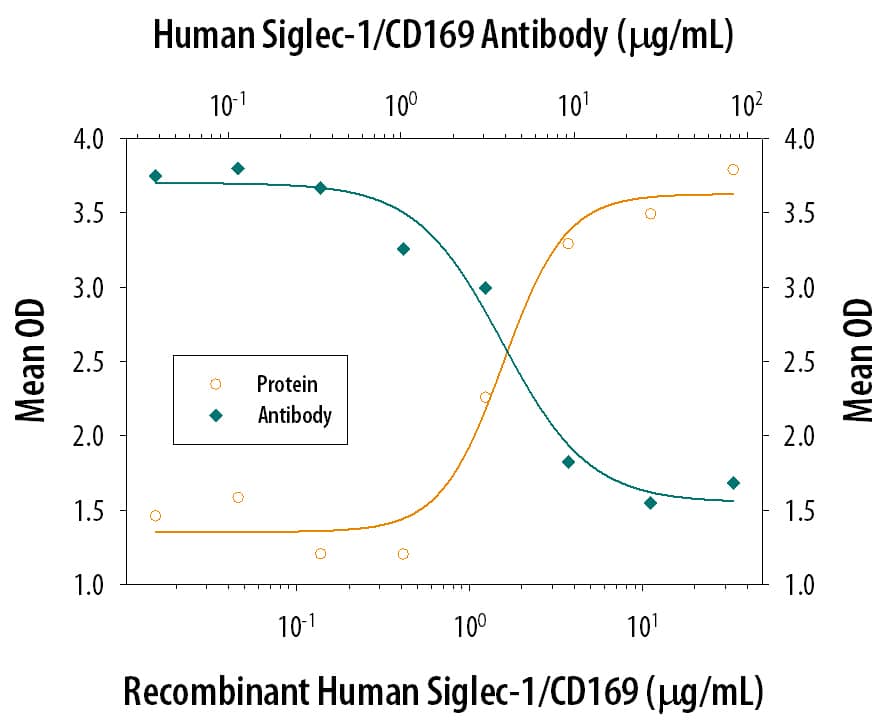Human Siglec-1/CD169 Antibody
R&D Systems, part of Bio-Techne | Catalog # AF5197


Key Product Details
Species Reactivity
Validated:
Cited:
Applications
Validated:
Cited:
Label
Antibody Source
Product Specifications
Immunogen
Ser20-Gln1641
Accession # Q9BZZ2
Specificity
Clonality
Host
Isotype
Endotoxin Level
Scientific Data Images for Human Siglec-1/CD169 Antibody
Detection of Human Siglec-1/CD169 by Western Blot.
Western blot shows lysates of SH-SY5Y human neuroblastoma cell line and human lymph node. PVDF membrane was probed with 0.5 µg/mL of Sheep Anti-Human Siglec-1/CD169 Antigen Affinity-purified Polyclonal Antibody (Catalog # AF5197) followed by HRP-conjugated Anti-Sheep IgG Secondary Antibody (HAF016). A specific band was detected for Siglec-1/CD169 at approximately 180-200 kDa (as indicated). This experiment was conducted under reducing conditions and using Western Blot Buffer Group 1.Cell Adhesion Mediated by Siglec‑1/CD169 and Neutralization by Human Siglec‑1/CD169 Antibody.
Recombinant Human Siglec-1/CD169 Fc Chimera (Catalog # 5197-SL), immobilized onto a microplate, supports the adhesion of human red blood cells in a dose-dependent manner (orange line). Adhesion elicited by Recombinant Human Siglec-1/CD169 Fc Chimera (5 µg/mL) is neutralized (green line) by increasing concentrations of Sheep Anti-Human Siglec-1/CD169 Antigen Affinity-purified Polyclonal Antibody (Catalog # AF5197). The ND50 is typically 1.5-7.5 µg/mL.Applications for Human Siglec-1/CD169 Antibody
Western Blot
Sample: SH‑SY5Y human neuroblastoma cell line and human lymph node
Neutralization
Formulation, Preparation, and Storage
Purification
Reconstitution
Formulation
Shipping
Stability & Storage
- 12 months from date of receipt, -20 to -70 °C as supplied.
- 1 month, 2 to 8 °C under sterile conditions after reconstitution.
- 6 months, -20 to -70 °C under sterile conditions after reconstitution.
Background: Siglec-1/CD169
Siglecs are sialic acid specific I-type lectins that belong to the immunoglobulin superfamily. Structurally, they are transmembrane proteins with an N-terminal Ig-like V‑set domain followed by varying numbers of Ig-like C2-set domains (1, 2). Human Siglec-1, also known as sialoadhesin and CD169, is a 175‑185 kDa glycoprotein. It contains a 1622 amino acid (aa) extracellular domain (ECD) with one Ig-like V‑set domain and 16 Ig-like C2-set domains, a 21 aa transmembrane segment, and a 44 aa cytoplasmic domain (3). Within the ECD, human Siglec-1 shares approximately 70% aa sequence identity with mouse and rat Siglec-1. Alternate splicing generates a potentially soluble form of the ECD, and a second isoform with a substituted cytoplasmic domain. Siglec-1 expression is restricted to lymph node and splenic macrophages, plus some tissue macrophages (3). The adhesive function of Siglec-1 is supported by the N-terminal Ig-like domain which shows a selectivity for alpha2,3‑linked sialic acid residues (3‑5). Siglec-1 binds a number of sialylated molecules including the mannose receptor, MGL1, MUC1, PSGL-1, and different glycoforms of CD43 (6‑9). Its binding capacity can be masked by endogenous sialylated molecules (10, 11). The sialylated and sulfated N-linked carbohydrates that modify Siglec-1 itself are required for ligand binding (6, 7). Siglec-1 is expressed on dendritic cells following rhinovirus exposure, and these DC promote T cell anergy (12). It is also induced on circulating monocytes during systemic sclerosis and HIV-1 infection (13‑15). Siglec-1 can trap HIV-1 particles for trans infection of permissive cells (14).
References
- Varki, A. and T. Angata (2006) Glycobiology 16:1R.
- Crocker, P.R. et al. (2007) Nat. Rev. Immunol. 7:255.
- Hartnell, A. et al. (2001) Blood 97:288.
- Nath, D. et al. (1995) J. Biol. Chem. 270:26184.
- Crocker, P.R. et al. (1991) EMBO J. 10:1661.
- Martinez-Pomares, L. et al. (1999) J. Biol. Chem. 274:35211.
- Kumamoto, Y. et al. (2004) J. Biol. Chem. 279:49274.
- Nath, D. et al. (1999) Immunology 98:213.
- van den Berg, T.K. et al. (2001) J. Immunol. 166:3637.
- Nakamura, K. et al. (2002) Glycobiology 12:209.
- Barnes, Y.C. et al. (1999) Blood 93:1245.
- Kirchberger, S. et al. (2005) J. Immunol. 175:1145.
- York, M.R. et al. (2007) Arthritis Rheum. 56:1010.
- Rempel, H. et al. (2008) PloS ONE 3:e1967.
- van der Kuyl, A.C. et al. (2007) Plos ONE 2:e257.
Long Name
Alternate Names
Gene Symbol
UniProt
Additional Siglec-1/CD169 Products
Product Documents for Human Siglec-1/CD169 Antibody
Product Specific Notices for Human Siglec-1/CD169 Antibody
For research use only
